Metal spike for floor standing speaker on wooden floor
|
Bronze Member Username: EddietfmanHong Kong Post Number: 18 Registered: Sep-05 | Can any experts tell for floor standing speaker placing on wooden floor, metal spike can help improve sound quality or not. I mean to put metal spike at the speaker bottom before placing on the floor. Or rubber feet are better than metal spike? |
|
Silver Member Username: Stu_pittNYC, NY Post Number: 756 Registered: May-05 | I went through the same dilema a few weeks ago. In my experience, the spikes are better than rubber feet. It seemed to clean up the sound. I didn't want to ruin the floors in my apartment, so after consultation on this board I ended up putting quarters under the spikes. To me it sounds much better than the rubber feet. Everyone's equipment and ears are different though. The best way to find out is to try for yourself. |
|
Silver Member Username: ExerciseguyBrooklyn, NY USA Post Number: 239 Registered: Oct-04 | Try these https://www.amazon.com/Dayton-Audio-ISO-4C-Chrome-Isolation/dp/B0002KR1Q4 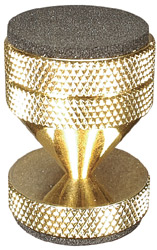 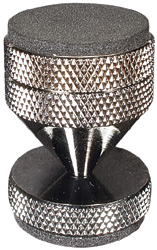 |
|
Silver Member Username: TwebbzAnn Arbor, Michigan USA Post Number: 275 Registered: Apr-04 | Putting coins under spikes will just make the speakers slide on the coins. Think about it. The points are not digging into anything. Rubber feet are the ticket for wood and tile floors, they grab and act like shock absorbers. Spikes are for stability digging into carpet, with the carpet acting like a cushion if it's thick enough. |
|
Silver Member Username: NuckParkhill, Ontario Canada Post Number: 400 Registered: Dec-04 | Canadian quarters have a slightly raised ridge on the circumference, and do not move around. And they are less than 25c US! |
|
Silver Member Username: NuckParkhill, Ontario Canada Post Number: 401 Registered: Dec-04 | Now yoyu want me to mail you some, right? can do. |
|
Silver Member Username: TwebbzAnn Arbor, Michigan USA Post Number: 276 Registered: Apr-04 | Na, I'm close to Canada...get them in my change all the time. I just go to the bank of the Detroit River and throw them back to Windsor. Hehehe! |
|
Silver Member Username: NuckParkhill, Ontario Canada Post Number: 428 Registered: Dec-04 | LOL Rick! In Ann Arbor, y'all might get them in a hat(if you play guitar) |
|
Gold Member Username: Jan_b_vigneDallas, TX Post Number: 6636 Registered: May-04 | The idea of spikes is not to "dig into" anything. What you achieve with the weight of the speaker focused onto the very small tip of a spike is mass loading. All of the weight is placed on four very, very small contact areas. This is what "locks" the speaker in place whether you use the spikes on a tile floor or to pierce the fibers of a carpet. Spikes are most effective on carpeted floors due to the resilience of the supporting surface with carpet. In either case, tile or carpet, the loading of the spikes should give the impression the speaker is bolted to the floor. Rubber feet, on the other hand, will supply a degree of compliance to the foundation of the speaker. Even more so when used on carpet which adds a degree of sponginess. In most cases this is an undesirable trait as it allows the speaker enclosure to move slightly due to the force of the woofer pressing against the resistance of the air it is trying to move. If it is easier to move the mass of the cabinet than the mass of air, the enclosure will move slightly and the woofer will not respond as quickly, or to the full extent, the signal requires. |
|
Silver Member Username: TwebbzAnn Arbor, Michigan USA Post Number: 277 Registered: Apr-04 | I would not want my wooden floor dug into or scratches in my tile. Rubber feet is the way I go on my wooden floor. |
|
Gold Member Username: Jan_b_vigneDallas, TX Post Number: 6637 Registered: May-04 | If you don't want to mar your wood floor, you can always place something between the spike and the floor. It's not going to slide around with a 65 lb. speaker loaded to the floor. Trust me. But, unless you constantly move your speakers around with the spikes in place, the spikes will barely dent your hardwoods. Remember we are talking about a very, very small contact point. By determining the correct placement before you put the spikes under the speakers, the spikes only have to contact the floor at one small location. Not enough that you are likely to notice unless you've managed to scratch the floor by constanty moving the speakers. |
|
New member Username: 2morexExmore, Virginia USA Post Number: 6 Registered: Nov-05 | Adona corporation sells solid brass "coasters" (for lack of a better word) that are designed for this task. They sell regularly on audiogon and come in black or brass. I empathize with scatched floors and it happens more often than not. |
|
Gold Member Username: Jan_b_vigneDallas, TX Post Number: 6640 Registered: May-04 | Is it possible to empathize with a wooden floor? Anthropomorphism aside, and all that stuff, you know. |
|
New member Username: 2morexExmore, Virginia USA Post Number: 7 Registered: Nov-05 | Good Point! I empathize with him for defending his hi-fi hobby when and if one of his kids or wife attempts to "adjust" his speakers and consequently leave him in a marital "mess". WAF and all that stuff, you know! |
|
Gold Member Username: Jan_b_vigneDallas, TX Post Number: 6642 Registered: May-04 | I have been in that situation. "Well, how was I to know there were spikes on the bottom of the speaker?" "That it didn't want to move and left gouges in the floor when it did, wasn't a clue, eh?" |
|
woodenfloor Unregistered guest | Finally. someone speaks up for me..sniff.. |
|
Gold Member Username: Jan_b_vigneDallas, TX Post Number: 6650 Registered: May-04 | Well, for God's sake, you've let yourself be walked on all these years!!!! |
|
PatrickNL Unregistered guest | Same here, got myself some nice Dynaudio Audience 52SE's on stands. The shop gave me a set of plastic 'UFO-like' save-your-floor-thingies with a little hole in the middle to put the spikes in. Me and my gf are going to experiment some with the speakers placing and when we're done, i'm gonna remove the little ufo's. Spikes will only leave real minor dents in the wooden floor. But my point really is: my girl supports me in removing those ugly ufo's as well as in removing the dustcaps, since that not only sounds, but also looks way cooler  Talking about WAF ;) Talking about WAF ;) Found this as well, might help? http://www.audioc.com/accessories1/misc/points.htm |
|
Silver Member Username: ExerciseguyBrooklyn, NY USA Post Number: 252 Registered: Oct-04 | Another good choice, other than the Isolation Cones (which are excellent) from www.partsexpress.com, are these rubber vibrapods http://www.vibrapod.com/ 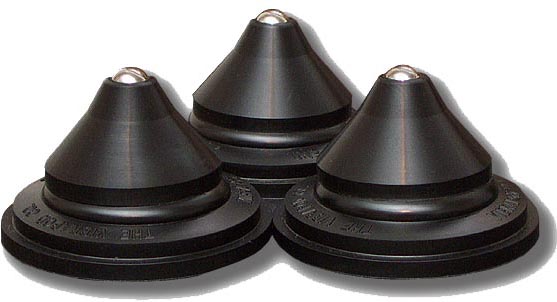 They work well, will not damage your floors, and are inexpensive. |
|
Gold Member Username: Jan_b_vigneDallas, TX Post Number: 6654 Registered: May-04 | I've not tried the Vibrapods under speakers but generally the idea is to fix the speaker in one location and not allow the enclosure to shift in relation to the movement of the woofer. From what I understand of the Vibrpods, their intent is to allow some movement but damp the movement quickly. That would seem to be going in the wrong direction from what spikes will accomplish. However, the ball bearing tip is a good idea since it will touch the floor only at a tangent and affect very much the same results as spikes. Both the ball and the spike place the mass of the speaker on a very small point of contact. |
|
Silver Member Username: ExerciseguyBrooklyn, NY USA Post Number: 253 Registered: Oct-04 | Yes, these cones can be used with the ball bearing up or down, with or without the pods. Given all the possible configurations, it should be possible to accomplish the task of effective vibration dampening & not damaging wood floors. |
|
Gold Member Username: Frank_abelaBerkshire UK Post Number: 1028 Registered: Sep-04 | I use English 1-pence pieces. 8-pence doesn't cost much and saves the wooden floor from damage. It also improves the sound, making the bass a little tighter and more tuneful - which is odd, since this goes against the whole 'coupling the speaker to the floor' principle. Then again, my speaker stands are so darned heavy there is no WAY they're not coupled to the floor even separated by 4 1-pence coins! I've listened briefly to Townshend Seismic Sink Speaker Stands which are small platforms on an air bearing (basically an inner tyre tube). They affect the sound significantly, not to my taste but lots of people swear by them. Regards, Frank. |
|
Silver Member Username: ExerciseguyBrooklyn, NY USA Post Number: 254 Registered: Oct-04 | When used ball bearing side down, the underside of the vibrapod cones are concave and affix to the underside of the speaker like a suction cup. When used in conjunction with the vibrapod base, this creates a system of a relatively small contact area, and a means on dampening residual vibration. The system seems to make sense to me, more so than some of the suggestions mentioned in this thread (spikes & coins). |
|
Silver Member Username: ExerciseguyBrooklyn, NY USA Post Number: 255 Registered: Oct-04 | 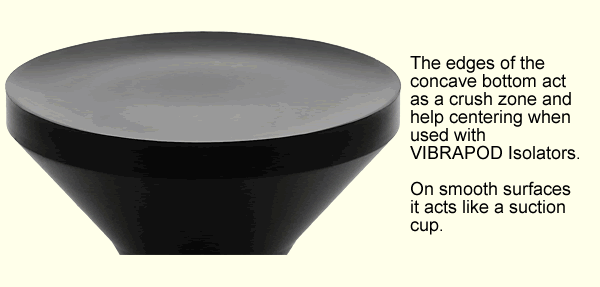 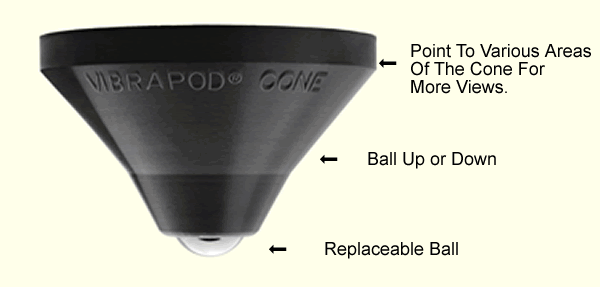 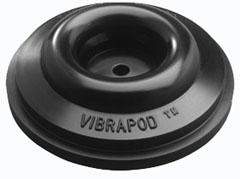 |
|
Gold Member Username: Frank_abelaBerkshire UK Post Number: 1030 Registered: Sep-04 | Christopher, The problem with vibrapods and the like is they allow the speaker enclosure to move. Once the drive unit starts to push air an equal and opposite reaction (thankyou Newton) takes place. Now the mass of the enclosure is large by comparison to the drive unit, but the fact remains it's not infinitely large so it will move to a greater or lesser extent. This causes the drive unit to push less air than it should to reproduce the correct signal. It can also cause a certain amount of interference, both constructive and destructive at different frequencies, between the drive unit and the cabinet which also introduce distortions of their own. Spikes and coins are good. They don't let the enclosure move, and with the correct mass loading, they sink the extra energy intot he floor very effectively, rather than isolating it in the speaker which a lot of vibration systems have a tendency to do (mainly because they vibrate at a particular frequency). Regards, Frank. |
|
Silver Member Username: ExerciseguyBrooklyn, NY USA Post Number: 256 Registered: Oct-04 | Frank, "The Law of Conservation of Energy states that energy cannot be created or destroyed, but can change its form." Given that there is bound to be some sort of vibration under the best circumstances, isn't it advisable to dampen rather than transfer that vibration? Does the spike/coin configuration lead to some sort of "room resonation" in most homes? What would you suggest as guidelines for "correct mass loading"? Thanks, Chris |
|
Gold Member Username: Frank_abelaBerkshire UK Post Number: 1032 Registered: Sep-04 | Chris, Thanks to the Law of Conservation of Energy the energy must go somewhere. Apart from transferring into pumped air, there is a huge amount of heat in the crossover and the movement of air inside the enclosure. This sets up vibrations or energy movement in the speaker itself. This extra energy needs to be diverted away from the speaker system quickly and efficiently, otherwise it impacts the speaker adversely in the time domain. The danger with any interface (such as stand/speaker) is reflection. You can minimise this by using upward facing spikes which amplify the transference away from the speaker into the stand due to their shape, or you can couple the speaker closely to the stand either by using bolts in rare cases or blutak more commonly. There are a couple of problems with damping in the vibrapod sense. First of all, there is a whole set of frequencies that need to be damped by the system (otherwise they keep bouncing around in the speaker), and different speakers have different characteristics meaning that the damping that should take place needs to be different for each speaker. Secondly, the vibrapods have quite a low resonant vibration frequency. At that frequency the speaker wobbles since it is setting them off (in the same way a room is set off when you hit its bass resonant frequency). The wobble acts as a spring, returning the energy back into the system. Room resonance is a factor of the room's dimensions, not the way the speaker is coupled to the floor. The coupling to the floor allows energy at various frequencies to dissipate into the floor. The faster this can be done, the better. The two main ways to do this have been: * very light open frame stands. The energy isn't held in the stand itself, and transfers immediately to the floor. Predominant in the eighties, this has become very much out of fashion, which is a shame since it seems to have been a very effective method. Many really musical speakers benefitted by being placed on open frame stands (Rega Kytes, Linn KAN, BBC LS3/5A, EPOS ES14, ES11, M12 to mention a few). They have very low WAF however, since they look like the industrial items they are. * mass loaded stands. The stand acts as an energy sink before dissipation into the floor. The argument here is that the appropriate mass loading does not set up a vibration or reflection of the energy back into the speaker system, and always dissipates the energy away from the speaker. however, different speakers need different mass loading because of the different energies they send into the stand, so one has to accommodate the speaker correctly. The correct mass loading is decided by the manufacturer of the speaker usually. So for example, EPOS 12.2s work brilliantly on the open frame stands which they were designed for, and simply 'die' with medium mass stands which are so prevalent nowadays (easy to make y'see). Most standmounts have a 'recommended stand' that goes with them which usually works best. Otherwise, it's up to the dealer to find which stands work best. I hope this is interesting... Regards, Frank. |
|
Silver Member Username: ExerciseguyBrooklyn, NY USA Post Number: 257 Registered: Oct-04 | Frank, Thanks for your insights. So if I understand you, the goal is to mechanically, preferably by spiking, affix a speaker to a stand with sufficient mass to dampen most vibration, and then disperse and residule vibration, also by means of spikes to the floor. Would the use of a coin cause the spike/coin combo to ride over the floor without some sort of mechanical fastening? |
|
Gold Member Username: Frank_abelaBerkshire UK Post Number: 1035 Registered: Sep-04 | Chris, You're welcome. There are two goals in fact. One is not to allow the speaker to move at all. The other is to sink any energy in the system away from the speaker. What I am saying is that the vibration systems fail definitely in one of the two goals, which is not to allow the speaker to move (very bad thing), so you're already losing the game. No amount of vibration management is going to redress that. The mechanical energy we're talking about is quite substantial so the means are fairly drastic. I'm not saying that spikes are the only way around this problem, but they are an effective one which works well in the majority of cases. After all, vibrapod will argue convincingly that they have worked out the vibrational issues, and so does Max Townshend. I remain unconvinced having heard both systems in a variety of situations. Now here's the kicker - I heard Max's supports when he was doing the demo, and we disagreed on which was the better sound! He preferred his supports since they cleaned up the sound so dramatically (a point I conceded). I preferred the speakers spiked directly to the floor because of the tighter faster presentation, even though it was noisier. No doubt that his stands work, I just don't like what they do. Also, the mass loading thing is a red herring since I have heard for myself the derogatory effect of a mass loaded stand under an EPOS M12.2 against its own (cheaper) open frame stand. As to the coin/spike issue, there was an interesting article in a recent HiFi+ where they discussed using floorsavers (coins/ discs/whatever) on various surfaces including carpet and the journalist claimed that the results were always better with the floorsavers in place. Now I haven't done as much work as the journo has but my resuilts with the coins under the stands are that there is no movement once everything is levelled up correctly. Don't forget that even a light speaker/stand combo, is going to exert prodigious pressure via those spikes due to the very low contact area. Regards, Frank. |
|
Gold Member Username: Jan_b_vigneDallas, TX Post Number: 6658 Registered: May-04 | OK, move over, let me through, come on, I got somethin' to say here! CM - You seem to be under the impression the function of spikes is to drain vibration from the speaker enclosure. That is virtually impossible with any material afixed to just one location (in this case the bottom of the cabinet), when the cabinet resonances are occuring at various points along the enclosure walls. And, of course, the largest, most damaging resonances/vibrations would exist along the greatest length and/or width or an area of high energy interface (think front baffle), which is seldom the base of the speaker. To dampen these vibrations takes an entirely different tact than placing spikes or vibration control devices along the underside of the cabinet. More on that if needed. The Vibrapods are effective at minimizing vibration which moves in one direction, acting as a mechanical diode to some extent; but are better used as isolation devices than as coupling devices since the rubber material allows, as has been pointed out, some sponginess which is ultimately ineffective as a drain. Your choice of tip up or down is a choice which is determined by what you are trying to accomplish. Tip up will isolate the equipment atop the cone by allowing a very small contact area between the dampening device and the equipment. It will not, however, allow the pod to drain energy from the equipment which is often what is desired when the equipment has a transformer that introduces vibration into the equipemnt and possibly the support surface. For that function the pod should be placed with the largest surface area in contact with the equipment allowing the vibration to be drained away from the equipment and transfered to the support shelf. Once again the small surface area of the tip will minimize the entry point for vibration which is moving up from the support surface to the equipment As Frank said, room resonances are determined by the dimensions of the room. The degree to which the resonances are excited is controlled somewhat by volume level. (The louder you play your system, the more you notice room resonances even though the resonant frequencies do not shift.) So, if the speaker produces less bass level due to poor coupling, then the room resonances will be diminished. This, in the long run, seems to be a poor trade since the benefits of firmly coupling the speaker to the floor is well worth the effort. The idea of spikes, as I have stated earlier, is to fix the speaker's enclosure in space allowing the woofer to move only in direct relation to the energy coming from the amplifier. Any other transfer of energy from electrical to mechanical will result in poor performance as signal is lost or distorted. Resting the speaker enclosure atop a spongey support surface sets in motion a rocking motion which continues to distort the signal long after the initial burst of energy. While spikes can act as an energy drain for cabinet resonances, the effect is minimal. The purpose for spikes, or ball bearings, is, short of screwing the speaker to an immovable object, fixing the speaker enclosure in space. This presents a firm foundation for the springiness of the driver's suspension to push against. All energy is transfered to the driver and none, other than internal resonances, to the cabinet. |
|
Gold Member Username: Jan_b_vigneDallas, TX Post Number: 6659 Registered: May-04 | I think what you are hearing in the Townshend unit is the support acting as a drain to reduce cabinet vibrations. It will, of course, suffer from the enclosure movement since it cannot hold the speaker firmly in space. This route, however, will display the quality of a cabinet that is less than effectively damped. This, and the results of the EPOS stand, will be a matter of what works best for any one design and listener. As with my audition of Tim's Ling speaker, there should never be an attempt to simply shift one idea which works for system "A" to system "B" without listening to the final result. Using a system which acts as an effective drain for cabinet vibration is not a bad idea. Allowing the cabinet to hold that vibration for a long period of time, which puts it out of phase with the original signal, can be far more detrimental than letting the cabinet release the vibration quickly and move on with the job of the next signal. In audio we hear the same effect when turntables are placed on heavy stands when a light support which releases energy quickly will give life to the system. Remember mass can be a damping system; but if not enough mass is added to effectively minimize the energy, then the mass simply acts as a phase shift filter which will always be less than satisfactory. |
|
Silver Member Username: ExerciseguyBrooklyn, NY USA Post Number: 258 Registered: Oct-04 | Thanks for the lesson guys. |
|
Silver Member Username: NuckParkhill, Ontario Canada Post Number: 456 Registered: Dec-04 | So a 300 lb, 1" oak or concrete, or whatever, cabinet,which exhibits no sympathetic resonance, and will absolutely not move is a place to start, then? |
|
Silver Member Username: Stu_pittNYC, NY Post Number: 759 Registered: May-05 | Nuck - I think that's the rationale behind the B&W Nautilius at only $40,000 a pair... |
|
Gold Member Username: T_bomb25Dayton, Ohio United States Post Number: 1299 Registered: Jun-05 | Thats exactly the how Roy Hall explained the Epos stand to me,to bad I,ve got to wait until feb. or march for the new shippment,damn Frank your making me paranoid,im calling around all over today im finding these stands as soon as possible,they were at a superspeaker level when I heard them,a astonishing acheivement for under $1500,one that I have never heard before,and timing and coherance and microdynamics better than everything I,ve ever heard and one of best speakers I,ve ever heard,yes the openframed stands make a huge difference.A dedicated stand from a company is always better than another stand,because it has been designed with the speaker to function as a whole. |
|
Gold Member Username: Frank_abelaBerkshire UK Post Number: 1043 Registered: Sep-04 | Nuck, No. A 300lb cabinet would be an effective energy sink, but if the energy stays within it without being dissipated effectively you're back to square one, so you have to ensure the energy is drained away into the floor somehow. The weight would limit your options in terms of floor mounting so you would have to design it yourself and ensure it couples well to the floor. Such a large and heavy design would interact more severely with the room's floor, so you wouldn't necessarily get such a brilliant result. Theoretically, the best would be a speaker of no mass at all since it won't be able to hold onto the energy and would dissipate it far more efficiently, but it's difficult to make speakers at all, let alone light ones that don't flap. It's a crazy business this hifi stuff... Regards, Frank. |
|
Anonymous | Just to throw a curve, then theoretically plannars are better that cones. |
|
Gold Member Username: Jan_b_vigneDallas, TX Post Number: 6665 Registered: May-04 | How in the world did you come up with that idea? Which has more chance of wasting energy? A small bookshelf speaker with a five inch woofer firmly mounted in a MDF enclosure and mounted atop a filled stand? Or, a planar with what constitutes a ship's sail for a driver stretched between narrow pieces of wood and then mounted atop a small pair of feet that measure about 1/10th the height of the speaker? What we have been trying to point out is those items which, at first glance, might appear to be "common sense" often fall short of accomplishing the objective when that same common sense falls short of completing the process and looking at the results of the intended action. In the case of most planar speakers, it is far more difficult to fix the driver in space than it would be with a driver in a cabinet. That should be obvious. |
|
Silver Member Username: NuckParkhill, Ontario Canada Post Number: 460 Registered: Dec-04 | Let alone light ones that dont flap... |
|
Silver Member Username: ExerciseguyBrooklyn, NY USA Post Number: 259 Registered: Oct-04 | What say you of these? 25lbs. a piece, loadable, $99. delivered from www.partsexpress.com Are they over-kill for a large pair of bookshelves? 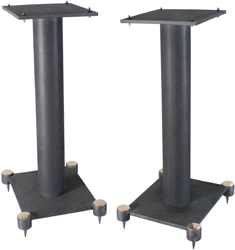 |
|
Gold Member Username: Jan_b_vigneDallas, TX Post Number: 6675 Registered: May-04 | If you will read what's been posted here, whether those stands work well is a matter of what your speakers would prefer to sit on. In general, a solid, non-ringing stand is the best place to start when trying out various stands. Whether the height of that stand is correct is another matter. If I had my druthers, and the budget, I'd almost always go with Sound Anchors. Their line of stands offers superior stability due to wider than normal bases, thicker gauge metals with large area posts and concrete filled supports for better than sand/shot damping. If your speakers want to be solidly fixed in space, there are few stands that compete with the Sound Anchor line up. They are not inexpensive but you do get what you pay for. There are some alternatives to the conventional stand design. Before just assuming the woofer and tweeter of your speaker should be mounted 32" off the floor, you might experiment with placement. By placing the drivers that far off the floor, you're going to create a situation where the signals leaving the speaker travel a different distance to your ears and to the first reflection point off the floor and ceiling. The signal that bounces off the floor and ceiling to arrive at your ears a short time after the direct signal will be out of phase with each other (usually) and with the direct signal which will therefore smear the time clues your brain uses to locate sounds in space. If you instead place the speaker close to the first reflection point off the floor, you have eliminated one more possible inaccuracy in your system and placed the ceiling reflection further away and lower in level where it is more likely to do less damage. The idea of a "X" inches high stand has become yet another item which people blindly accept as being correct for their system without ever questioning what the other effects of the "tweak" will do to their system. By placing the drivers close to the floor you take advantage of a "pressure zone" effect. The speakers will operate into a different space than when mounted on a stand and the signals will not have a severe time smear as they arrive at your ears. To use this placement you must, of course, tilt the speaker upwards to aim the tweeters at your listening position. Depending on the speakers and the amount of bass emphasis they have in the 50-150Hz range, you should experiment with the height of the stand with a the minimum being about 5" off the floor to an maximum of approximately 18". Some speakers will not benefit from this placement and will sound best on more conventional stands. But do try this set up and do not merely assume what is convention is the best set up for your system. Listen and decide for yourself. The set up I suggest before you purchase any tall stand uses a $1.19 cement block from Home Depot, a short section of plywood, MDF or even a cutting board to place between the cement block and your speaker along with a small device (I use a TipToe under the plywood panel but you could just as easily experiment using a wood screw through the plywood) to both tilt the speaker back and to further isolate from and load the speaker to the cement block. With the cement block flat on the floor, the height of the "stand" is 8". With the block on one end the height is 16". Experiment with both heights and listen for the sound you prefer. When I used the Rogers LS3/5a's in the front room, which is fairly lively, the 8" height worked extremely well. The soundstage was larger and instrument placement was better defined than when the speakers were on a tall, shot/sand filled stand. In the room where the system now resides, the Rogers are back on slightly taller stands but still tilted backwards. The speakers are PlastiTak'd to the plywood but not to the stand. Either way, the final decision was based on listening and not assuming. Check out the stands on this site: Also mounting the speaker with the tweeter on top and the woofer on the bottom is a convention we all accept without asking if there is a better sounding alternative. I have placed speakers on their side and used a damping device (you can try a double baggie full of lead shot or a 10lb. diver's weight) on the long dimension of the cabinet. This goes at the problem of the longest panel in the enclosure being the most likely source of resonance. By afixing the one long dimension to the stand you have damped that side. By using a damping device on the other side you've cut down another source of distortion in the system. It all comes down to trying to get the most out of the speaker and not just doing what you've always seen before. |
|
Silver Member Username: ExerciseguyBrooklyn, NY USA Post Number: 260 Registered: Oct-04 | Since this is an audiophile-on-budget set-up, price is a very serious consideration. I own a pair of Parts Express/Dayton satellite speaker stands and am very happy with the purchase, they are very heavy and well built. The 24" stands above seem to meet my needs, functionally & fiscally. |
|
Silver Member Username: NuckParkhill, Ontario Canada Post Number: 501 Registered: Dec-04 | So Jan, the setup I had in college in 19..(never mind), was actually mt first succesful audio experiment! The block was in house, although the chair sat crooked after i yanked out the block, The speaker on its side, cause somebody tumbled into it, and a 24 of cans on top as a weight, was spot on! I gotta start writing this stuff down! And in fact, the highs were bearing off of the ceiling(smooth, no stucco). An application of blueprints on heavy used bond provided the answer to that for my old paradigms. It is funny how things work out sometimes, no? |
|
Gold Member Username: Jan_b_vigneDallas, TX Post Number: 6679 Registered: May-04 | Funny. ha. |
|
Anonymous | NUCK, NUCK, NUCK, WHY WHY WHY? Now Jan will write another one of his exhaustive epistles. Let a sleeping dog lie! |
|
Silver Member Username: NuckParkhill, Ontario Canada Post Number: 502 Registered: Dec-04 | I rather enjoy his insight, Vooldemort. |
|
Silver Member Username: NuckParkhill, Ontario Canada Post Number: 503 Registered: Dec-04 | And just to enjoy the thought of you furiously pounding out, in protective anonymimnity, in capitals, and in sheer frustration the message as provided above. I find Anons to be rather boorish, when not being honestly seeking one time information, and enjoy little more than listening to ranting, however well informed at times, as it makes me wonder whom might need to remain so incogneto. Batman? Nah been done in the bat-theatre. Superman? Nope, would write audio reviews(wearing glasses, nooobody would know). Wonder Woman? ( I wish...are you?, BTW). So I herebt denounce all Anon posters as im-posters, and invite you to expose yourselves(wow it's Bob Parr!). Or be in the anon protection program(no internet for you!) |
|
Gold Member Username: Jan_b_vigneDallas, TX Post Number: 6682 Registered: May-04 | Nuck - You seem unusually frisky of late. what's the story? Are the meds finally kicking in? |
|
Silver Member Username: NuckParkhill, Ontario Canada Post Number: 507 Registered: Dec-04 | I get tired of all the nasty stuff here lately. Seems nobody has much of a sense of humour, except your tastes like chicken bit, Jan. ROFL, really. I think I duckout for a spell. Adios. |
|
Bronze Member Username: 2morexExmore, Virginia USA Post Number: 17 Registered: Nov-05 | Bad day at the office Nuck? Most all of us enjoy Jan's insight as well as yours, different as the two of you are. Don't walk away simply because some anon ruffles your feathers. Personally I read more negativity from you, chill man. See you back on line tomorrow! I came in late tonight, missed your humor. Happy Thanksgiving to you and Jan even if you don't celebrate this great day in our northern neighbor. |
|
Gold Member Username: Jan_b_vigneDallas, TX Post Number: 6685 Registered: May-04 | And to everyone, a happy dead meat filled with antibiotics, hormones, sodium and assorted petrochemical by products day. Enjoy! |
|
Gold Member Username: ArtkAlbany, Oregon USA Post Number: 2297 Registered: Feb-05 | Better dead meat than live! |
|
Gold Member Username: Jan_b_vigneDallas, TX Post Number: 6695 Registered: May-04 | Like so many things, that would be a matter of perspective. |
Main Forums
Today's Posts- Home Audio Forum
- A/V Receivers Forum
- Amps Forum
- Cassette Forum
- CD Players Forum
- CD Recorders Forum
- DAC & Transports Forum
- DVD-Audio & SACD Forum
- Equalizers Forum
- Integrated Amps Forum
- iPod Docks Forum
- MiniDisc Forum
- Mini Systems Forum
- Digital Music Systems Forum
- Phono Forum
- Preamps Forum
- Speakers Forum
- Subwoofers Forum
- Tuners Forum
- Home Video Forum
- Home Theater Forum
- Car Audio Forum
- Accessories Forum
- All Forum Topics